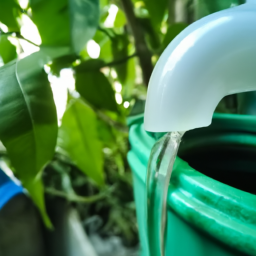Gardening 101 How To Use Kitchen Waste Water
Table of Contents []
- How To Use Kitchen Waste Water For Gardening
- What is Kitchen Wastewater?
- Is it Safe to Use Kitchen Wastewater on my Plants?
- Which Foods Can I Use?
- Can I Use Kitchen Wastewater with my Potted Plants?
- What Methods Can I Follow to Reuse Water from my Kitchen?
- What Types of Plants are Ideal Candidates?
- In Summary
How To Use Kitchen Waste Water For Gardening
Everyone wants to make a differenceand as simple a step as it may seem, home gardening can have a big impact on our environmental wellbeing. Not only is it a great way to reduce your carbon footprint and provide your household with nutrient-rich consuming options, but you can also use your kitchen wastewater to nourish your growing efforts.
What is Kitchen Wastewater?
Kitchen wastewater is water generated from activities such as food preparation, cooking, and cleaning in a kitchen. It's a great source of plant-nourishing nutrients, such as phosphorus and nitrogen.
Is it Safe to Use Kitchen Wastewater on my Plants?
Yes! As long as you treat it correctly, kitchen wastewater can be very safe if you treat it correctly. This may include using hot water or boiling it. With the help of a microbiologist, you can also measure or test your wastewater for safety levels, like Bacillus subtilis and Staphylococcus aureus.
Which Foods Can I Use?
Most organically-sourced foods are safe to use in kitchen wastewater. While you can use nearly anything, organic fruits and vegetables are the ideal choice for feeding your plants as they're packed with minerals and other nutrients such as nitrogen, potassium, and phosphorus. To boost the nutrient-content, blend your scraps with garden soil before use.
Can I Use Kitchen Wastewater with my Potted Plants?
Potted plants are excellent candidates for kitchen wastewater as their porous sides ensure that the liquid can soak in and reach the root zone. Once you select the plants, prepare a mixture of kitchen wastewater and soil. Whenwatering, sprinkle the blend slowly, overwatering can burn the roots of the plants, so ensure that the water drains well between applications.
What Methods Can I Follow to Reuse Water from my Kitchen?
Collecting and using kitchen wastewater can be done in a few simple ways:
- Utilize a bucket or jug to collect wastewater and vegetables scraps from your kitchen after meals and store in the fridge.
- Set up a simple drain system connected to your kitchen sink. It should have two levels: one for collecting wastewater that should be directed to the ground and one for collecting compost scraps.
- You can also build a simple irrigation system, using PVC and some recycled parts, to send your wastewater to your garden.
What Types of Plants are Ideal Candidates?
When selecting plants to use kitchen wastewater, go for common plants with sturdy root systems that can withstand the nutrient-heavy liquid. Common examples include celery, tomatoes, cauliflower, carrots and okra.
In Summary
Using kitchen wastewater on plants is an effective way to ensure that our produce can grow effectively while still minimizing our environmental footprint. While it may seem daunting at first, all you need is an understanding of safety levels, the correct method of application, and the right types of plants. Following these guidelines will help ensure both compost and your plants stay healthy and vibrant.
This article is for informational purposes only, and should not be taken as specialist advice.

Previous Page
Next Page
